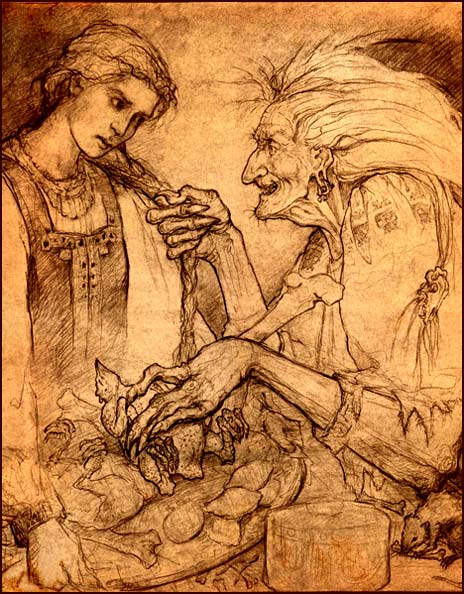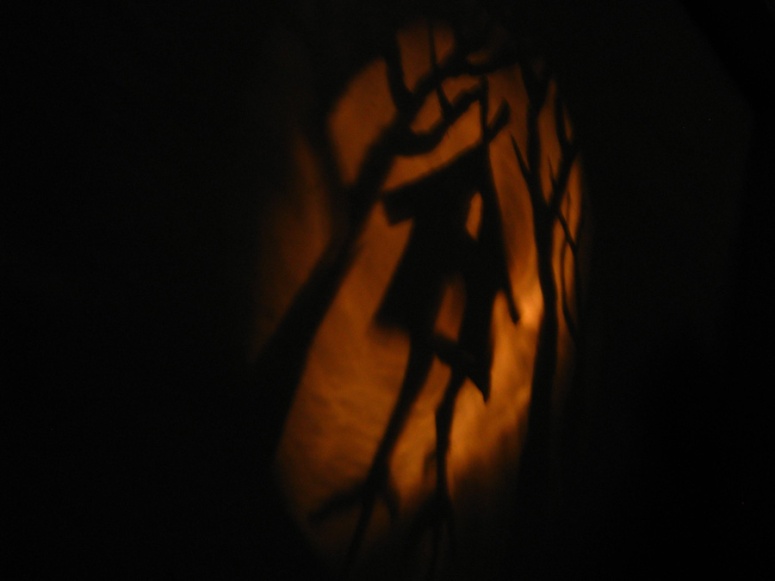
Samhain greetings and hedgespells from the edge of these misted, damp dark Dartmoor days! As you’re all bound to be Appreciators of Story and Lovers of the Uncanny, we thought to bring you a small offering from the Hedgespoken basket of witchlore for your enjoyment this All-Hallowed Eve, as we tip into the dark half of the year, and head inwards to firesides and tales with cracklings of imagined others behind us out there in the snow-laden dark.
Baba Yaga is probably our favourite witch. She is ubiquitous in Russian and Slavic folklore, and is famous for living in a house which stands on chicken legs (sometimes two, sometimes four, sometimes just the one). She flies through the air in a mortar and pestle and sweeps away her tracks with a broom. Her teeth are made of iron. Her garden fence is made of children’s bones. And the manner in which you approach her hut is all important…
In fact, there are many Baba Yagas. In some tales, she will be described as a Baba Yaga, and you might get to meet her sisters throughout the course of the story. There are many many stories in which she appears, and her hut in the forest becomes like an initiatory cave where you win her approval if you can approach with truth and wits about you. There’s also a deep deep witch-fear, which Baba Yaga represents; she is old as the hills, and cunning. She is kindly Baboushka and terrifying ogress.
I created the drawing above for a piece in Marvels & Tales, a peer-reviewed international journal publishing scholarly work dealing with the fairy tale in its diverse manifestations and contexts. It accompanied my article (and two other drawings of mine) on the old woman in the woods as a fairytale character.
The Baba Yaga below was painted for The Baba Yaga Book – The Wild Witch of the East in Russian Fairy Tales by Sibelan Forrester et al, published by Mississippi University Press. This lavish collection of Baba Yagas in story and art comes highly recommended!

The etymology of Baba Yaga’s name is fascinating and ambiguous. Baba is generally agreed to have come from the Slavic word describing an old woman or grandmother, but the second part is more problematic. Various scholars have put forward ideas as to its origins, from the Proto-Slavic *ož and Sanskrit अहि ahi, meaning ‘serpent’ or ‘snake’, to the Saami/Finnish mythological female goddess Akka. In other Slavic countries Baba Yaga is called by different names, further describing her personality: in Serbian and Croatian she is jeza (‘horror, shudder, chill’), in Slovenian jeza (‘anger’), in Old Czech jězě (‘witch, legendary evil female being’), in modern Czech jezinka (‘wicked wood nymph, dryad’), and in Polish jędza (‘witch, evil woman, fury’). The term appears in Old Church Slavonic as jęza/jędza (meaning ‘disease, illness’).
Whoever she is, she continues to inspire artists of all varieties. Here’s a small selection of representations of the old Yaga, which I particularly like:




She is depicted in various popular Russian artforms from fine lacquerwork:
to Lubok – popular Russian prints. Here below she is shown riding a pig into battle against some kind of creature, and below, dancing to the bagpipes!


Her chicken-legged house even appears secretly in Slavonic folk embroidery as a talismanic solar motif [source]:
As for filmic Baba Yagas, I wanted to bring your attention to the work of Jessica Oreck of Myriapod Productions, who has created The Vanquishing of the Witch Baba Yaga ~ “Deep in the forest, wedged in cracks in the bark and under the moss covered rocks, hide memories and myths. These subconscious tales, drawn from the natural world, inform the societies we build.” Jessica Oreck’s fantastical work combines animation, traditional storytelling and contemporary non-fiction filmmaking to recount the Slavic fable of the witch Baba Yaga. This fascinating work weaves together the culturally ingrained fear of this mythic witch, Eastern Europe’s turbulent history, and changing society’s perception of nature.
So there I leave you, and for the darkening night – a story. This one, a classic Baba Yaga tale, in which an animistic world helps the protagonists to escape the most fearful witch of them all…
SOMEWHERE, I cannot tell you exactly where, but certainly in vast Russia, there lived a peasant with his wife and they had twins — a son and daughter. One day the wife died and the husband mourned over her very sincerely for a long time. One year passed, and two years, and even longer. But there is no order in a house without a woman, and a day came when the man thought, “If I marry again possibly it would turn out all right.” And so he did, and had children by his second wife.
The stepmother was envious of the stepson and daughter and began to use them hardly. She scolded them without any reason, sent them away from home as often as she wished, and gave them scarcely enough to eat. Finally she wanted to get rid of them altogether. Do you know what it means to allow a wicked thought to enter one’s heart?
The wicked thought grows all the time like a poisonous plant and slowly kills the good thoughts. A wicked feeling was growing in the stepmother’s heart, and she determined to send the children to the witch, thinking sure enough that they would never return.
“Dear children,” she said to the orphans, “go to my grandmother who lives in the forest in a hut on hen’s feet. You will do everything she wants you to, and she will give you sweet things to eat and you will be happy.”
The orphans started out. But instead of going to the witch, the sister, a bright little girl, took her brother by the hand and ran to their own old, old grandmother and told her all about their going to the forest.
“Oh, my poor darlings!” said the good old grandmother, pitying the children, “my heart aches for you, but it is not in my power to help you. You have to go not to a loving grandmother, but to a wicked witch. Now listen to me, my darlings,” she continued; “I will give you a hint: Be kind and good to everyone; do not speak ill words to any one; do not despise helping the weakest, and always hope that for you, too, there will be the needed help.”
The good old grandmother gave the children some delicious fresh milk to drink and to each a big slice of ham. She also gave them some cookies—there are cookies everywhere—and when the children departed she stood looking after them a long, long time.
The obedient children arrived at the forest and, oh, wonder! there stood a hut, and what a curious one! It stood on tiny hen’s feet, and at the top was a rooster’s head. With their shrill, childish voices they called out loud:
“Izboushka, Izboushka! turn thy back to the forest and thy front to us!”
The hut did as they commanded. The two orphans looked inside and saw the witch resting there, her head near the threshold, one foot in one corner, the other foot in another corner, and her knees quite close to the ridge pole.
“Fou, Fou, Fou!” exclaimed the witch; “I feel the Russian spirit.”
The children were afraid, and stood close, very close together, but in spite of their fear they said very politely:
“Ho, grandmother, our stepmother sent us to thee to serve thee.”
“All right; I am not opposed to keeping you, children. If you satisfy all my wishes I shall reward you; if not, I shall eat you up.”
Without any delay the witch ordered the girl to spin the thread, and the boy, her brother, to carry water in a sieve to fill a big tub. The poor orphan girl wept at her spinning-wheel and wiped away her bitter tears. At once all around her appeared small mice squeaking and saying:
“Sweet girl, do not cry. Give us cookies and we will help thee.”
The little girl willingly did so.
“Now,”gratefully squeaked the mice, “go and find the black cat. He is very hungry; give him a slice of ham and he will help thee.”
The girl speedily went in search of the cat and saw her brother in great distress about the tub, so many times he had filled the sieve, yet the tub was still dry. The little birds passed, flying near by, and chirped to the children:
“Kind-hearted little children, give us some crumbs and we will advise you.”
The orphans gave the birds some crumbs and the grateful birds chirped again:
“Some clay and water, children dear!”
Then away they flew through the air.
The children understood the hint, spat in the sieve, plastered it up with clay and rilled the tub in a very short time. Then they both returned to the hut and on the threshold met the black cat. They generously gave him some of the good ham which their good grandmother had given them, petted him and asked:
“Dear Kitty-cat, black and pretty, tell us what to do in order to get away from thy mistress, the witch?”
“Well,” very seriously answered the cat, “I will give you a towel and a comb and then you must run away. When you hear the witch running after you, drop the towel behind your back and a large river will appear in place of the towel.
If you hear her once more, throw down the comb and in place of the comb there will appear a dark wood. This wood will protect you from the wicked witch, my mistress.”
Baba Yaga came home just then.
“Is it not wonderful?” she thought; “everything is exactly right.”
“Well,” she said to the children, “today you were brave and smart; let us see to-morrow. Your work will be more difficult and I hope I shall eat you up.”
The poor orphans went to bed, not to a warm bed prepared by loving hands, but on the straw in a cold corner. Nearly scared to death from fear, they lay there, afraid to talk, afraid even to breathe. The next morning the witch ordered all the linen to be woven and a large supply of firewood to be brought from the forest.
The children took the towel and comb and ran away as fast as their feet could possibly carry them. The dogs were after them, but they threw them the cookies that were left; the gates did not open themselves, but the children smoothed them with oil; the birch tree near the path almost scratched their eyes out, but the gentle girl fastened a pretty ribbon to it. So they went farther and farther and ran out of the dark forest into the wide, sunny fields.
The cat sat down by the loom and tore the thread to pieces, doing it with delight. Baba Yaga returned.
“Where are the children?” she shouted, and began to beat the cat. “Why hast thou let them go, thou treacherous cat? Why hast thou not scratched their faces?”
The cat answered: “Well, it was because I have served thee so many years and thou hast never given me a bite, while the dear children gave me some good ham.”
The witch scolded the dogs, the gates, and the birch tree near the path.
“Well,” barked the dogs, “thou certainly art our mistress, but thou hast never done us a favor, and the orphans were kind to us.”
The gates replied:
“We were always ready to obey thee, but thou didst neglect us, and the dear children smoothed us with oil.”
The birch tree lisped with its leaves, “Thou hast never put a simple thread over my branches and the little darlings adorned them with a pretty ribbon.”
Baba Yaga understood that there was no help and started to follow the children herself. In her great hurry she forgot to look for the towel and the comb, but jumped astride a broom and was off. The children heard her coming and threw the towel behind them. At once a river, wide and blue, appeared and watered the field. Baba Yaga hopped along the shore until she finally found a shallow place and crossed it.
Again the children heard her hurry after them and so they threw down the comb. This time a forest appeared, a dark and dusky forest in which the roots were interwoven, the branches matted together, and the tree-tops touching each other. The witch tried very hard to pass through, but in vain, and so, very, very angry, she returned home.
The orphans rushed to their father, told him all about their great distress, and thus concluded their pitiful story:
“Ah, father dear, why dost thou love us less than our brothers and sisters?”
The father was touched and became angry. He sent the wicked stepmother away and lived a new life with his good children. From that time he watched over their happiness and never neglected them any more.
How do I know this story is true? Why, one was there who told me about it.
From: Folk Tales From the Russian, by Verra Xenophontovna Kalamatiano de Blumenthal, [1903], at Sacred Texts


PS Remember to subscribe to this blog (hedgespoken.wordpress.com) to keep up-to-date with what we’re doing, and please like the facebook page and follow us on twitter to keep involved in the full frenzy of the fray! And don’t forget, you can support our project by donating or sharing from the Hedgespoken Crowdfunding page too.






Thankyou so much for this abundance of treasure!
Thank you for this wonderful blog about Baba Yaga. So well written, too. Happy Samhain to you and yours.
Thank-you for this post…Now I begin to understand the artwork. A great way to begin my final day of October
Thank you for these Baba Yaga stories. It’s fun to know how the ideas from our great grandparents and parents time fits into our lives now. My mom always told me that animals and birds are fairys and elves that had to change their shape so they could be safe around people. In my home, when my children were growing, I asked them to be kind to all animals and plants. I asked my kids to take bugs that got lost inside the house back outside so the bugs could get back home. I told my kids that when they did this kindness it built up a pile of good luck for them that would help them in their future when they needed help. Now as adults they still do this and are finding their own ways to be caring. One time a wild deer walked up to my adult sons and let them touch it.
It is such a good thing to know that Baba Yaga is alive and well. Thanks to people like you Rima. This is an exquisite treatise on this famous Russian Witch. I have know of her since my 5th grade class, when our teacher read us a tale. Baba Yaga has been a part of my life ever since. If you check out my FaceBook page, you will see a work that my husband created…. ‘Baba Yaga’s Cauldron’. http://www.facebood.com/Sacred.Sparks Thank you so much… Linda Beers Aydlott, Northern Michigan ~♡╭დ~•*`☽•L۞vE‿❥~•
Great post, thanks for sharing these lovely pictures. I grew up with tales of Baba Yaga thanks to an old copy of ‘Old Peter’s Russian Tales’ that we had in the house – I picked it up again recently, and it is still as magical as I remembered. Even the smell of the old book brought back powerful memories of childhood chills…
I really enjoyed this
Loved your paintings of Baba Yaga! Very deep, a bit scary and real! Did you read per chance Vladimir Propp’s “Morphology of the Folktale”?
Thanks all! Glad you’ve enjoyed this!
Vanya – no, I haven’t read any Vladimir Propp, tho have known for a long time that I should! Pleased my paintings ring true :) So often I find non-Slavic artists don’t get enough of the ancientness and fear into their depictions of Baba Yaga.
Linda – thanks – that cauldron is fabulous!
Vasilissa Most Lovely is one of my favourite folk tales – I as given a book of folk and fairy tales from around the world as a small child, and that was in it – it has remained a favourite of mine well into adulthood, and I tel it to my own children now. :)